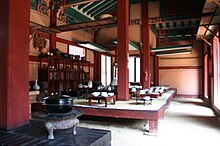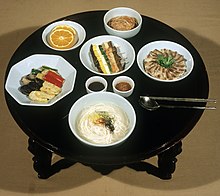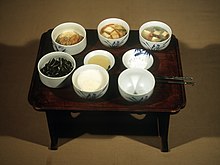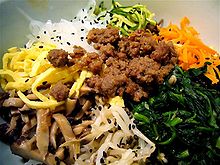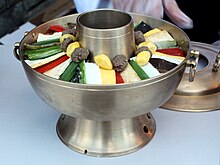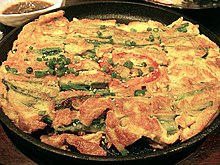
Korean cuisine has evolved through centuries of social and political change. Originating from ancient agricultural and nomadic traditions in Korea and southern Manchuria, Korean cuisine reflects a complex interaction of the natural environment and different cultural trends.

Mandu, or mandoo, are dumplings in Korean cuisine. Mandu can be steamed, boiled, pan-fried, or deep-fried. The styles also vary across regions in the Korean Peninsula. Mandu were long part of Korean royal court cuisine, but are now found in supermarkets, restaurants, and snack places such as pojangmacha and bunsikjip throughout South Korea.

Noodle soup refers to a variety of soups with noodles and other ingredients served in a light broth. Noodle soup is a common dish across East Asia, Southeast Asia and the Himalayan states of South Asia. Various types of noodles are used, such as rice noodles, wheat noodles and egg noodles.
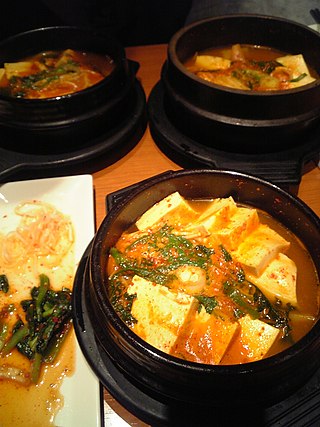
Jjigae are Korean stews. There are many varieties; they are typically made with meat, seafood or vegetables in a broth seasoned with gochujang, doenjang, ganjang or saeu-jeot. Jjigae is often served as a communal dish.

Banchan are small side dishes served along with cooked rice in Korean cuisine. Banchan are set in the middle of the table to be shared. At the center of the table is the secondary main course, such as galbi or bulgogi, and a shared pot of jjigae. Bowls of cooked rice and guk (soup) are set individually. Banchan are served in small portions, meant to be finished at each meal and replenished during the meal if not enough. Usually, the more formal the meals are, the more banchan there will be. Jeolla province is particularly famous for serving many different varieties of banchan in a single meal.

Korean noodles are noodles or noodle dishes in Korean cuisine, and are collectively referred to as guksu in native Korean or myeon in hanja character. Preparations with noodles are relatively simple and dates back to around 6000 BCE to 5000 BCE in Asia. In Korea, traditional noodle dishes are onmyeon, called guksu jangguk, naengmyeon, bibim guksu, kalguksu, kongguksu among others. In royal court, baekmyeon consisting of buckwheat noodles and pheasant broth, was regarded as the top quality noodle dish. Naengmyeon, with a cold soup mixed with dongchimi and beef brisk broth, was eaten in court during summer.

Padang dish or Minangkabau dish is the cuisine of the Minangkabau people of West Sumatra, Indonesia. It is among the most popular cuisines in Maritime Southeast Asia. It is known across Indonesia as Masakan Padang after Padang, the capital city of Western Sumatra province. It is served in restaurants mostly owned by perantauan (migrating) Minangkabau people in Indonesian cities. Padang food is ubiquitous in Indonesian cities and is popular in neighboring Malaysia and Singapore.

Jeongol (Korean: 전골) is a Korean-style hot pot made by putting meat, mushroom, seafood, seasoning, etc., in a stew pot, adding broth, and boiling it. It is similar to the category of Korean stews called jjigae, with the main difference being that jjigae are generally made with only a single main ingredient, and named after that ingredient, while jeongol usually contain a variety of main ingredients. An additional difference is that jeongol was originally a dish for upper-class Koreans and members of the royal court, while jjigae was a simpler dish for commoners.
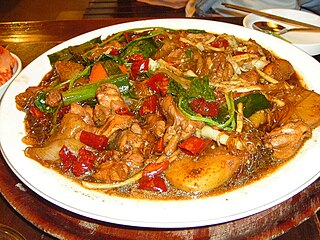
Jjim is a Korean cuisine term referring to dishes made by steaming or boiling meat, chicken, fish, or shellfish which have been marinated in a sauce or soup. The cooking technique originally referred to dishes cooked in a siru by steaming. However, the name jjim has now come to imply a finished dish with a steamed appearance. The cooking method for most jjim dishes nowadays has changed to boiling the ingredients in broth and reducing the liquid. Pressure cookers are popular for making jjim as well.
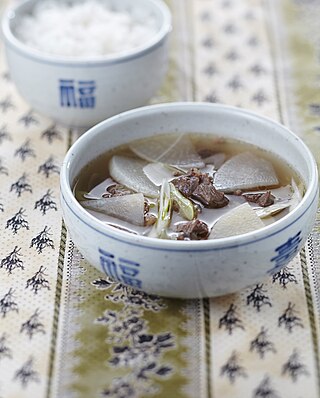
Guk (국), also sometimes known as tang, is a class of soup-like dishes in Korean cuisine. Guk and tang are commonly grouped together and regarded as the same type of dish, although tang can sometimes be less watery than guk. It is one of the most basic components in a Korean meal, along with bap, and banchan. In Korean table setting, guk is served on the right side of bap (rice), and left side of sujeo.

Seon (Korean: 선) is a traditional Korean dish made from steamed vegetables such as zucchini, cucumber, eggplant or Napa cabbage and stuffed with meat. Although the term is a counterpart of jjim — a category of dishes that are made by steaming meat or seafood — the concept is not clearly settled.

Pyeonyuk is a traditional Korean dish, which consists of thinly sliced meat that has been boiled and pressed. Either beef or pork may be used to make the dish.
Korean regional cuisines are characterized by local specialties and distinctive styles within Korean cuisine. The divisions reflected historical boundaries of the provinces where these food and culinary traditions were preserved until modern times.

Hot pot or hotpot, also known as steamboat, is a dish whereby a heat source placed on the dining table keeps a pot of soup stock simmering, and a variety of Chinese foodstuffs and ingredients are served beside the pot for the diners to put into the hot stock.

North Korean cuisine is the traditional culinary practices and dishes of North Korea. Its foundations are laid by the agricultural and nomadic traditions in southern Manchuria and the Korean Peninsula. Some dishes are shared by the two Koreas; however, availability and quality of Northern cuisine is much more significantly affected by sociopolitical class divides.

Doenjang-guk (Korean: 된장국) or soybean paste soup is a guk (soup) made with doenjang and other ingredients, such as vegetables, meat, and seafood. It is thinner, lighter, and milder than doenjang-jjigae. It is similar to the Japanese miso soup. It is sometimes mild, sometimes strong, and accompanied with rice most of the time.

